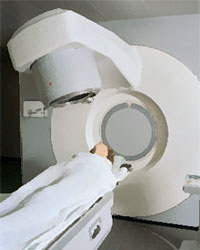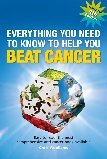A patient-friendly review of ovarian cancer, a cancer that begins in the ovaries or fallopian tubes, looking at the types, symptoms, causes and treatment alternatives - from the involvement of pathogens and viruses to treatments from immunotherapy to building an off-label drug protocol.
Ovarian cancer - increasing your personal odds of survival
 Ovarian cancer is often dubbed ’The Silent Killer’. The reason is because the symptoms often show up late and, on diagnosis, the patient is already deemed stage 3 or stage 4, with metastases to lymph nodes or further afield. Only 20% of cases are diagnosed at an early stage, according to the American Cancer Society.
Ovarian cancer is often dubbed ’The Silent Killer’. The reason is because the symptoms often show up late and, on diagnosis, the patient is already deemed stage 3 or stage 4, with metastases to lymph nodes or further afield. Only 20% of cases are diagnosed at an early stage, according to the American Cancer Society.
We have had a large number of ladies who have approached us over the past 15 years with their ovarian cancers in just such a state. However, in a good number of those cases, where the patient was open-minded about using complementary and new, emerging therapies and so building an integrative treatment programme, we have seen positive results; and despite even a prognoses of just a few months to live, they are alive and well many years later.
One lady we now know well, approached Chris Woollams in 2004 when she was told to go and write her will. She is alive and well today; Galina exercises daily, watches her diet carefully and has used complementary therapies and alternative treatments after the orthodox therapies had failed and she was given just three months to live by her oncologist.
Go to: How Galina beat her Ovarian cancer with CANCERactive
Today, Galina is absolutely clear of her ovarian cancer. We put together an Integrative personal program for her.
But we have others; 12 years on, 9 years on - all originally given just 12-18 months. There is so much you can do to empower yourself with ovarian cancer. The fact is that you must think 'outside of the box'. Stamford University conducted a review of ovarian cancer survival in America and determined that orthodox medicine - the drugs, hysterectomy and more drugs - had little to do with survival and that age seemed the only real determinant!
You can read more about what people think of Chris Woollams' Personal Prescriptions here.
What is ovarian cancer?
Ovarian cancer is a type of cancer that usually starts on or in the ovaries. The ovaries are slightly larger than a peanut and produce hormones such as oestrogen , progesterone and testosterone. Women have two ovaries, one either side of the womb. Each month, one of the ovaries produces an egg (an ovum), and this is caught by hair like appendages on the Fallopian tubes. One Fallopian tube to one ovary, the Fallopian tubes carry the eggs to the womb.
There are more than 30 different types of ovarian cancer, each usually gaining its name from the tissue that gave rise to the cancer. For example:
Epithelial Ovarian cancer - originally thought to start in the epithelial surface cells of the ovary, these carcinomas account for 90% of all ovarian cancer cases. Be aware that not all such tumours are cancerous - many are benign.
- Serous Ovarian cancer - these account for three quarters of the cases of Epithelial ovarian cancer and now, according to OVCARE, the majority have been shown to originate in the Fallopian tubes. Because of this, the cancer can spread rapidly and the majority of cases are called High Grade Serous Ovarian cancer.
- Mucinous ovarian cancer - this accounts for about 30% of the Epithelial Ovarian cancer cases. These tend to be discovered earlier, although they can spread rapidly around the peritoneum and to other organs such as the liver, lungs, breast and brain, if left unattended!
Stromal Cell ovarian cancer - these are cancers that develop inside the ovaries; they tend to start in the connective tissue that holds the ovary together, or even in the hormone producing cells. Although rare, these cancers tend to be diagnosed at a much less advanced state.
Germ cell tumours - these are formed in the egg producing cells and tend to occur in much younger women (teens and early 20s). 90% of these can be cured.
The Causes of Ovarian Cancer
Ovarian cancer affected over 7,450 British women in 2017, making it the fourth most common form of cancer in women.
Ovarian cancer develops mostly in women over 55, and half of all cases occur in women of 65 plus, although one in ten patients, nowadays, will be under 45 and that figure is increasing. Official statistics claim 35% of those diagnosed will be alive 10 years later - but it is better to look into the detail. Seventy per cent of women on diagnosis with ovarian cancer find that it has already spread beyond the ovaries, which is why the overall five-year survival rate is low. However, if your cancer is diagnosed early and has not spread outside the ovary then official US figures show their women have a 94 per cent chance of surviving 5 years (90 per cent in UK).
In 2017 in the UK there were 4116 deaths from ovarian cancer.
Go to: Ovarian cancer - Latest News, Latest Research
1. Mutation and ovarian cancer
Some 25% of Epithelial Ovarian cancers are thought to be linked to BRCA1 and BRCA2 mutations.
Soon after being diagnosed, many women, especially in the USA, are tested for hereditary gene mutations - for example for BRCA1 or BRCA2 genes. A 2017 study showed that the repair genes of Lynch syndrome (PMS2, MSH2, MSH6, and MLH1) were also risk factors, Recently a team led by Dr. Lydia Usha felt that mutations RAD51C, RAD51D, and BRIP1 were the most relevant. All are on the National Comprehensive Cancer Network list(1).
However, you should know that there is research showing that having a BRCA1 or BRCA2 mutation does not affect your survival chances once you have the disease. Indeed there are even drugs specifically for people with such mutations.
Go to: Having a BRCA1 or BRCA2 mutation makes no difference to survival
2. Oestrogen and ovarian cancer
Increased risk has been linked to pregnancy infrequency, low breastfeeding, early menarche, late menopause and the use of HRT and the oral contraceptive pill.
For example, women who have no children are more likely to develop this cancer, and women who start a family after 30 also have a slightly higher risk. Menstruation patterns are also implicated - more monthly periods may increase the risk; women who began their periods before the age of 12, who had a late menopause and did not breastfeed may also have a higher risk.
Xeno-oestrogens - eg. Phthalates from plasticisers in bottles, BPA from white can linings, toluene in nail polishes, and chemicals in perfumes, soaps and sunscreens; then chemicals in herbicides like DDT and Lindane - have increasingly been found to mimic the action of oestrogen once inside the body. Dr Ana Soto in the USA, one of the World’s leading experts on this subject, has shown that these can have a cumulative effect and are definitely linked to cancer. They tend to be stored in fatty tissues of the body.
Go to: Live Clean; remove the chemicals of concern from your life
Women who have had breast cancer are also more likely to develop ovarian cancer. So, you may be starting to feel that there is an oestrogen factor at work,and in the USA many women with ovarian cancer are told immediately whether they test positive for estrogen. It is probably the case in about 75% of ovarian cancers. You can do a lot to control your estrogen levels yourself.
Go to: 10 ways to cut your estrogen naturally
 HRT
HRT
Cancer Research UK have at last confirmed what we have been telling people for more than a decade: Taking HRT triples your cancer risk. In the Boston Nurses study back in the 90s, HRT increased risk of ovarian cancer by 40 per cent after 7 years and 70 per cent after 11 years. This risk has been confirmed in the US in 2003 and with CRUK’s million women study. Synthetic oestrogen teamed up with synthetic progesten seems worse. (NB. Synthetic Progesten has been implicated in the risk of several cancers. Natural Progesterone, which you make yourself, is on the other hand very protective. Please read our article on Natural Progesterone.)
Contraceptive pill
As we warned you for more than a decade, the contraceptive pill is not 'safe'. The low estrogen pills are no safer than the high dose pills of 20 years ago! Another Medical Myth!
Go to: Even lose dose contraceptive pills increase cancer risk
3. Inflammation and ovarian cancer
Inflammation is a significant risk factor and females who have experienced pelvic inflammatory disease (PID), endometriosis. Inflammation also plays a key role in cancer spread, and NSAIDs like a small daily aspirin have been shown in research to reduce inflammation and spread. But there is specific research on Indomethacin and how it could reduce the inflammation and spread of ovarian cancer.
Overweight women are more at risk from cancer in general. Being overweight is linked to inflammation and poor hormonal control. Fat stores toxins and hormones you would normally want to excrete, and indicates poor eating habits and a less active lifestyle, all contributory factors.
4. Chemicals and ovarian cancer
Frequent exposure to talc and asbestos have an increased risk of ovarian cancer (2). Courts in America have placed big fines on companies for causing such deaths, without warning people of the dangers of using products containing talcum powder, for example.
There is also research that certain toxins, for example mercury, can heighten risk of ovarian cancer; and there is research on deficiencies of vitamins B-12, folic acid and other B vitamins being linked to increased risk. You should know that a healthy gut helps remove toxins from the body; and the gut bacteria also make your B vitamins
5. Dairy and ovarian cancer
There is clear research from both the US and the Karolinska institute that dairy consumption increases ovarian cancer risk. Research published in the American Journal of Clinical Nutrition tracked 61,000 women for 13 years.
Women who consumed just a cup of milk a day have an increased risk and women who consumed more than the equivalent of a pint of cows’ milk a day have twice the risk.
6. Infection and ovarian cancer
This has been another game changer in understanding Ovarian cancer. In a study (3) 80% of ovarian cancer patients tested positive for chlamydia, but this was not confirmed in any other study. But other research shows higher levels than normal of HPV in several studies.
However, in one of the most important recent studies(4), Scientists at University of North Carolina Lineberger Comprehensive Cancer Centre found pathogens in the Upper Reproductive Tract of women with epithelial ovarian cancer. The tract was previously thought to be sterile.
Go to: Pathogens found in upper reproductive tract in ovarian cancer
Importantly, the bacterial composition of the tract (fallopian tubes, ovaries) was completely different in women with cancer to those who were healthy.
Researchers used genetic sequencing to study the types of bacteria present and even found different bacteria present in the fallopian tubes and the ovaries.
Certainly pathogens could cause localised inflammation through their toxic waste-products. They also produce micro-RNA messages that can alter their environment, by over-riding the host micro-RNA.. Thus they are capable of influencing both the development and aggression of ovarian cancer.
Perhaps the presence of pathogens is why we at CANCERactive have seen a significant benefit from the use of herbs (such as oregano and artemisinin) with ovarian cancer patients. Colonies of bacteria are similar throughout the body. The pathogens in the ovaries and Fallopian tubes are likely to be similar to those in the gut and even in the mouth and gums.
Another pathogen sometimes present is E coli. This is more often found in UTIs, and bladder and kidney cancers, but is also found in womb (Endometrial) cancer. There is so much you can do to help yourself.
Go to: Heal your Gut; Heal your Body
7. Low Vitamin D levels
Approximately 80% of women on diagnosis have poor vitamin D levels below 20 ng/ml. The NHS believes safe levels start at 35-40 ng/ml. The experts are Boston Medical School who believe that people should be above 70 ng/ml.
People with low vitamin D get more cancer; people who have cancer and low vitamin D levels have poor survival levels; and people who go in the sun and/or supplement with 5,000IUs of vitamin D a day(or 3 - 4 hours in the sun), survive longer. Drugs can halve plasma levels just when you need them to be high so take a double dose of D3. Without Vitamin D your immune system simply cannot attack rogue cells - cancer or infection. The immune system, however much the white cells increase, is inert.
Screening for Ovarian cancer
The two tests most commonly used in ovarian cancer are the Ca-125 test and Transvaginal Ultrasound (TVUS). The problem is that other health conditions (e.g. endometriosis, hepatitis, ovarian cysts) can affect the Ca-125 protein in a blood test, although once you are diagnosed it is a useful tool for showing if your cancer is rising or falling. Many of the anomalies found using TVUS are benign.
So, at the moment there is no definitive test for early diagnosis.
A potential game changer came in 2018 with an Neu5Gc blood test (7) which would allow much earlier detection.
The problem with screening, however, is that false positives are common and false negatives also occur. Also, despite the ’early diagnosis saves lives’ rhetoric, Medics have also yet to establish beyond any doubt that screening would actually save a life. If you are diagnosed earlier, simple maths and logic makes it more likely that you survive 5 years. That is not the same as beating the disease.
So, early days yet, and funding could well be the ultimate issue as every woman at risk will need to be screened and ovarian cancer is just not high up the Medical World’s priorities. Ovarian cancer doesn’t get as much attention as breast cancer because it affects only 17 per cent as many women. Sad, but that’s the way Government Health Departments think.
Symptoms of ovarian cancer
Once known as the "silent killer" (because it gives few, if any, warning signs at the early stage where treatment can be successful) ovarian cancer is perhaps more usefully described as the "whispering" disease, because women who listen to their bodies carefully may just pick up possibly life-saving signs. These include:
-
Pelvic or abdominal discomfort and pain
-
Cramps
-
Bloating or swelling
-
Loss of weight or appetite
-
Fatigue
-
Breathlessness
-
Backache
-
Urinary problems
-
Unexplained changes in bowel habits
-
Unusual Vaginal bleeding
Ovarian Cancer Action suggest women look for a constant feeling of being bloated and an increase in abdominal girth, without any evidence of weight gain elsewhere. The first symptom is often urinary urgency.
Orthodox ovarian cancer therapies
 1. Ovarian cancer Surgery: Where the cancer has not spread, the most common medical treatment is surgery. A cut is made through the abdominal wall (a laparotomy) and the ovaries, fallopian tubes and the womb are then removed. This is called a total abdominal hysterectomy. This is a major operation and can be extensive. Many doctors in America routinely test the cancer tissue to see whether it is oestrogen positive (ER+ve). This can determine the use of drugs later on - Aromatase Inhibitors being increasingly used.
1. Ovarian cancer Surgery: Where the cancer has not spread, the most common medical treatment is surgery. A cut is made through the abdominal wall (a laparotomy) and the ovaries, fallopian tubes and the womb are then removed. This is called a total abdominal hysterectomy. This is a major operation and can be extensive. Many doctors in America routinely test the cancer tissue to see whether it is oestrogen positive (ER+ve). This can determine the use of drugs later on - Aromatase Inhibitors being increasingly used.
Chemotherapy may sometimes be used before surgery to make the tumour more manageable in terms of size. Obviously this total removal has implications for hormone levels (and hence all manner of side effects such as skin tone and hair loss). In pre-menopausal women it means infertility. Surgery is also used to discover the extent of the cancer. Sometimes the doctors do not know whether there is spread or not until they have operated.
In cases where the cancer has spread to the bowel, the surgery may well be accompanied by some removal of the colon and that may, or may not, involve having a temporary ileostomy bag. You should ask your surgeon about this risk, although he may not know the level of spread before he operates.
2. Chemotherapy for ovarian cancer: Most commonly used after surgery, when there is spread or a fear of remaining cancer cells. The most common drugs used are Taxol (paclitaxel) and carboplatin. Cisplatin may be an alternative in some cases and Avastin may be used with the first two drugs, or as a follow up.
Topotecan, gemcitabine and doxorubicin might also be recommended. For information on your Cancer Drugs and chemotherapy click here.
A huge international study of 477 women with early ovarian cancer from 84 centres in five countries concluded that Carboplatin is the gold standard chemotherapy for these particular ovarian cancer patients, although increasingly it is used with Paclitaxel.
Dr. David Guthrie, an expert in ovarian cancer treatment, explains that even if surgery appears to remove all visible evidence of ovarian cancer, some microscopic deposits may persist and cause a recurrence in about a third of patients even when diagnosed at an early stage.
The key question for oncologists has been whether to wait and see and give chemo only when a recurrence is found, or to give it routinely after surgery. This recent trial however suggests that survival is increased by 9 per cent if Carboplatin is given within six weeks of surgery.
Go to: How to improve the success of your chemo, while reducing side-effects
What is clear is that there is a real risk of women having the chemotherapy and an operation, only to see the return in the perineum, all too quickly. One reason for this could be that the surgery involves large doses of antibiotics and these together with the chemo drugs cause damage to the commensal bacteria. As a result, there is less restriction on pathogens in the tubes, and no control over yeast excesses. Taking yeast killers like oregano oil or caprylic acid along with a good probiotic during surgery and chemotherapy have been shown to restrict yeast excesses. Artemisinin has been shown to be helpful in dealing with pathogens. It is imperative for women having surgery and chemotherapy that they pay attention to their microbiome.
Go to: Heal your Gut; Heal your Body

Ovarian Cancer Immunotherapy - is an increasing option. Immunotherapy is being studied in combination with VEGF inhibitors, PARP inhibitors or other immunotherapy drugs.
PARP inhibitors stop cancers repairing their DNA, and are particularly interesting where patients have a BRCA mutation. In 2014 the FDA approved olaparib, in 2016 rucaparib, and in 2017 niraparib. Several others are in clinical trials.
Women with BRCA mutations who respond to PARP inhibitors seem likely to respond to immunotherapy too. Keytruda (pembrolizumab), a monoclonal antibody, is being studied with ovarian cancer. It binds to specific receptors on immune cells called Programmed Cell Death 1 or PD-1. It is also being studied for use with Avastin and/or cyclophosphamide. Another PD-1 inhibitor Opdivo (Nivolumab) has shown promise in ovarian cancer.
Go to: Overview of Immunotherapy
3. Radiotherapy: This is rarely used for ovarian cancer usually after surgery and chemotherapy have been tried, and to manage pain. The beam can hit other tissues and cause damage and side-effects, which you should ask about. You should also look at our article on how to maximise the effectiveness of your Radiotherapy.
So does standard orthodox medicine cure ovarian cancer?
You should be aware of the following:
i). Charn et al in the British Journal of Cancer, (vol 95, Issue 10, in 2006) have concluded from Research at Stamford UCLA, that younger women diagnosed with ovarian cancer have a greater chance of 5-year survival. Especially women under 30 although then the researchers admitted there aren’t too many of those!
ii). The same researchers found that there was no significant survival difference amongst the 16-40 year old child-bearing group whether they had uterine sparing surgery or those who had standard surgery removing the womb as well. So you might as well spare your uterus.
iii). The Lancet Oncology (Vol 7 Issue 8; 607) reports research on patients having chemotherapy and radiotherapy. The radiotherapy-only route produces a 4-year survival of 63 per cent. The chemotherapy adds nothing at all. The researchers from the cancer centre in Serbia and Montenegro concluded that there was no benefit in having chemotherapy over just radiotherapy.
4. Treatment for anaemia: Managing and counteracting anaemia can reduce death from anaemia by 50 per cent. Research published by the Cochrane Collaboration showed that epoetins (alfa and beta epoetin) show significant survival benefits. Particularly striking were the results for patients with solid tumours (Breast, lung, colon, ovarian) where risk of death decreased by 51 per cent) In a second study (European Soc. For Medical Oncology- 31st Oct 2005) epotin beta was shown to reduce risk of tumour progression in patients with anaemia
5. Treatment for fatigue: icon has run several pieces on fatigue. A qualified naturopath will be able to suggest dietary changes to boost energy levels. Qualified homeopaths may be able to suggest ways to counter fatigue. Energy therapists ( eg. acupuncture, cranial osteopaths, Reiki Masters) may well be able to help.
Ovarian cancer, ascites and secondary cancer in the peritoneum or liver
If the Doctors fail to stop the cancer, despite their surgery, their drugs and their radiotherapy, women find their ovarian cancer progresses to the liver or the peritoneum.
Ascites can also be a problem; they are a build up of fluid in the abdominal cavity. Ascites often cause the stomach to appear swollen.
We have so much information on this Website that can help you.
Ovarian cancer - alternative treatments
Some examples:
1. When women have cancer cells scattered in the peritoneum they may be offered surgery and then a 1 hour 'flush' with chemotherapy. This protocol is called HIPEK.
Go to: HIPEK
2. Then there is the use of off-label drugs. These are old drugs originally intended to treat another illness (e.g. Diabetes - metformin); or lower fat (a low fat diet increases survival in ovarian cancer - but atorvastatin can reduce blood fats too). One drug - a beta-blocker called Propranolol is being investigated by Professor Sood of MD Anderson, after he noticed it extended survival times by 4 years in women who were co-incidentally taking it.
Go to: Beta-blocker Propranolol could provide extra years for ovarian cancer patients
But there are other repurposed drugs that can be beneficial - Dipyridamole and LDN for example; or taking an antihistamine like cimetidine or Loratadine immediately after surgery. There are expert oncologists in the USA and UK using some of these in protocols right now. And you might look into these.
Go to: Building a personal off-label drugs protocol
Confused by all this? Worried about all the information out there? Or think you may be missing something important? Why not approach CANCERactive for a Personal Program with Chris Woollams?
Go to: What patients say about Personal Prescriptions
3. Another consideration is that any original issues of yeasts, pathogens or even parasites causing the cancer, may well have been worsened by the drugs and the antibiotics that went with the doctors' solution. You really must take some action - you can kill the bad' and replenish the 'good'.
Go to: All cancer begins in the gut
4. Oregon State University have pionered a double approach using Photodynamic therapy together with gene therapy (6). First the patient is given a photosensitising agent (phthalocyanine) and then DJ-1 a gene therapy of small interfering RNA to weaken the cancer cells further This nanotechnology approach allows infrared light to penetrate the body much deeper. In animal studies all the cancer cells were killed wherever they were located.
There are ’alternative’ treatments if the can causes a liver tumour: For example by using the Nanoknife IRE:
Go to: The Nanoknife
5. But it is important to undestand that everybody should start with a disciplined diet and exercise program, plus key supplements like vitamin D, anti-inflammatory fish oils and turmeric, and an anti-pathogen programme.
Go to: Diet and exercise guidelines to increase survival
Every month we add News Items to this Website - we also have a specific page for ovarian cancer. Why not sign up for the latest information, and go and visit this specific page next:
Go to: Ovarian Cancer - Latest News, Latest Research
* * * * * * * *
Putting together a complementary and integrative ovarian cancer treatment plan
There is so much you can do to help yourself. The aim of CANCERactive is to short circuit all the information for you and to empower you to increase your personal odds of survival.
This is also why we have books like ’Everything you need to know to help you beat cancer’; or ’The Rainbow Diet and how it can help you beat cancer’; or ’Oestrogen - the killer in our midst’; and ’Heal your Gut - Heal your Body’

All are relevant to this cancer.
First, you should sign up for Chris Woollams e-newsletter.
Go to: Sign up for the latest news on your cancer
It comes out every two weeks and you will find articles in it such as this:
Go to: Hemp oil slows ovarian cancer spread
Complementary ovarian cancer therapies and Alternative ovarian cancer therapies?
CANCERactive is Europe’s Number 1 Integrative Cancer Charity. This website alone has more than 4,000 pages of information on it, either as articles or as news stories. More than 10,000 people visit our websites every day. We know from the feed-back we receive just how much we are valued by people trying to beat cancer.
We believe you can increase your personal odds of cancer survival by taking simple health-enhancing steps and adding both complementary cancer therapies and alternative cancer therapies into your mix of treatments.
For example, Hyperbaric Oxygen, curcumin, calorie restriction, melatonin, probiotics and whole body hyperthermia have all been shown in research to make chemotherapy work better. It kills more cells! The research is covered on this website. Surely it makes a lot of sense to use them in your personal cancer treatment programme?
We have a complete review of Immunotherapy telling you the accurate figures and what to watch out for. We tell you what is working and when two new drugs have been used, rather than one. It’s a new, emerging and alternative cancer therapy, but not fully there yet!
Go to: A complete review of Immunotherapy
Then we have an article on how to improve the success of your radiotherapy (and reduce the potential side-effects) – all by adding complementary therapies. Our Guidelines on Diet and Exercise can be found through this link:
Go to: CANCERactive Guidelines on Diet and exercise
Our recommended anti-cancer diet is the colourful Mediterranean Diet (with its focus on the French paradox):
Go to: The Rainbow Diet
Like Hippocrates, we believe all cancer begins in the gut and that gut problems, yeast, viral and parasite infections are common constituents of cancer.
Go to: All cancer begins in the gut
But if you just want to look at the most comprehensive list of Complementary Therapies you can find it here:
Go to: CANCERactive Complementary and Integrative cancer therapies
And if you want alternative cancer therapies start here:
Go to: CANCERactive Alternative cancer therapies
Finally, if you want all this put together for you in one simple plan, why not look into having a Personal Prescription?
Go to: Personal Prescriptions with Chris Woollams
We don’t take one penny from any Pharmaceutical company, cancer clinic or supplements company. We have no vested interest. We just want to see you beat cancer.
"If you are already thinking of supplementing with any of the above products, why not take a look at Our Natural Selection by clicking here."

The CANCERactive Difference:
Intelligent Information. Independent Voice.

Refs:
- Oncology Times: May 10th, 2017 - Volume 39 - Issue 9 - p 28–29
- https://www.ncbi.nlm.nih.gov/pmc/articles/PMC5529868/
- Shanmughapriya etal; Eur j Clin Microbial infec Diseases; 2012 Sept; 31, 2311-7.
- https://healthtalk.unchealthcare.org/bacteria-found-in-female-upper-reproductive-tract-once-thought-sterile/
- OVCARE
- Canan Schumann, Olena Taratula, Oleh Khalimonchuk, Amy L. Palmer, Lauren M. Cronk, Carson V. Jones, Cesar A. Escalante, Oleh Taratula. ROS-Induced Nanotherapeutic Approach for Ovarian Cancer Treatment Based on the Combinatorial Effect of Photodynamic Therapy and DJ-1 Gene Suppression. Nanomedicine: Nanotechnology, Biology and Medicine, 2015; DOI: 10.1016/j.nano.2015.07.005
- https://www.sciencedirect.com/science/article/pii/S0006291X18323957?via=ihub
IMPORTANT NOTICE
|
* Cancer (and its related illnesses) are very serious and very individual diseases. Readers must always consult directly with experts and specialists in the appropriate medical field before taking, or refraining from taking, any specific action.
This web site is intended to provide research-based information on cancer and its possible causes and therapies, so that you can make more informed decisions in consultation with those experts. Although our information comes from expert sources, and is most usually provided by Professors, scientists and Doctors, our easy-to-understand, jargon-free approach necessitates that journalists, not doctors, write the copy. For this reason, whilst the authors, management and staff of CANCERactive, icon, and Health Issues have made every effort to ensure its accuracy, we assume no responsibility for any error, any omission or any consequences of an error or omission. Readers must consult directly with their personal specialists and advisors, and we cannot be held responsible for any action, or inaction, taken by readers as a result of information contained on this web site, or in any of our publications. Any action taken or refrained from by a reader is taken entirely at the readers own instigation and, thus, own risk.
|